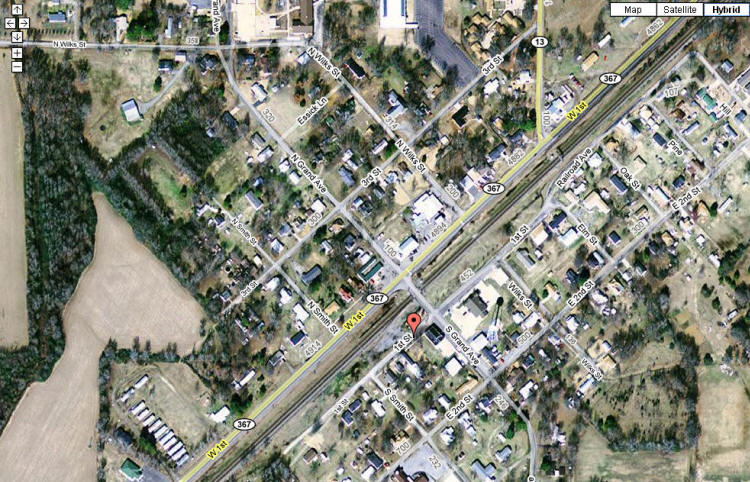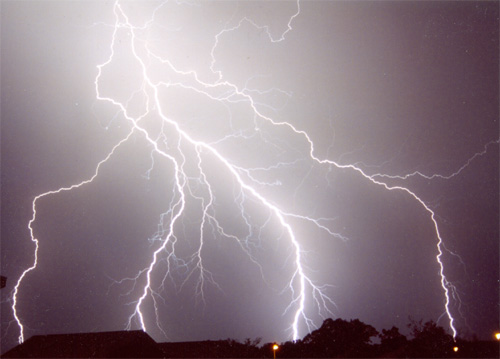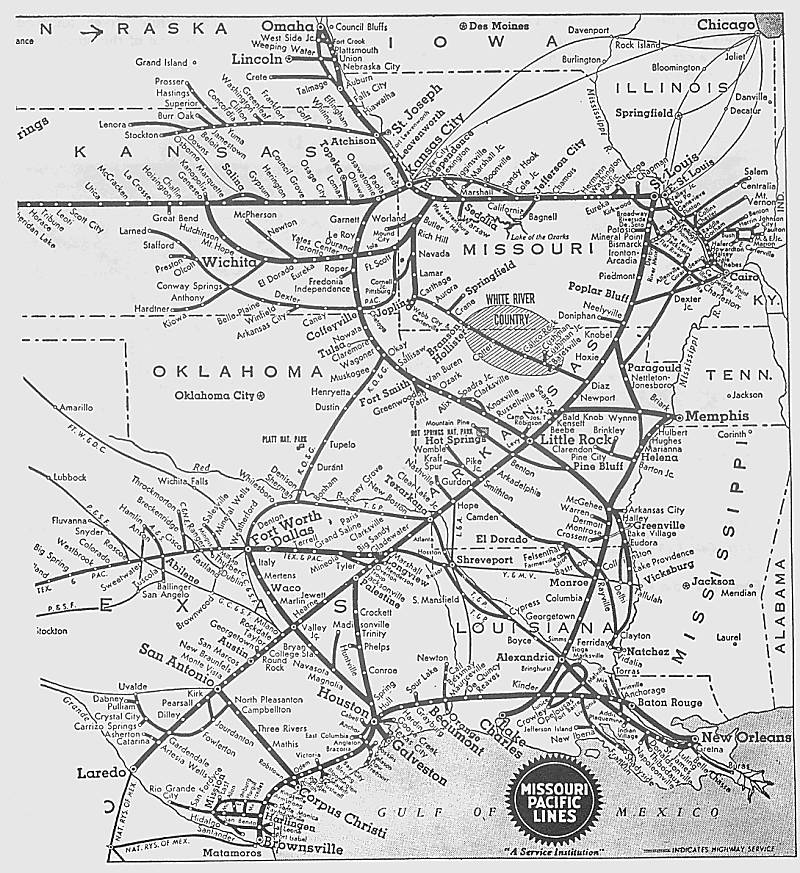Dad's Hometown
We all had a hometown but our families pretty much stayed put. The Liles were originally from North Carolina and moved to White County Arkansas to a town called McRae in the late 1880's and planted their roots. Dad and his sisters stayed in the area until the 1930's when they moved on to California to escape the depression that stayed in Arkansas for years.
Off We Go With A Cloud Of Dust And a Hi-Yo Silver

The annual trek was on! Los Angeles to McRae in three days flat and that was flying considering the highways were generally two lanes and always under construction. I-40 did not exist so we were on High 66 for a long time and turned south across New Mexico and Texas.
In those days you would get up at 2:00 am and leave so you did not have to be in the dessert during the heat of the day... No air conditioning existed in cars we could afford!
It Is Hugh Today By Yesterday's Standards

A Google map search reveals the town of 500 people! They lived on North Grand, fourth house from the highway and train line.
McRae Arkansas Was Just Outside Little Rock (40 Miles)

Forty miles seems like nothing today but in the 1900's when Dad was growing up, it was an adventure as they had no cars, there were no paved roads only a train which was built to export strawberries!
The names of the surrounding towns were always amazing to me, such as: Bald Knob, Bliss, Denmark, Turnip, Negrohill, BeeBee, etc.
The area was heavily wooded in the early days with wood being a major product of the area.
I do remember the summer heat and the bugs and especially the lightning bugs that would dart around all night!
Who Was McRae?
McRae was named after Dandridge McRae (1829-1899) was a Brigadier General in the Confederate States Army during the American Civil War. Dandridge McRae was born on 10 October 1829 in Baldwin County, Alabama. McRae graduated from South Carolina College in 1849. McRae moved to Searcy in White County, Arkansas. He was admitted to the bar and served as clerk of the county and circuit courts for six years. In 1861 when Arkansas seceded from the Union he was Inspector General of Arkansas. He entered the Confederate Army as a Major in command of the 3rd Arkansas Infantry Battalion.
McRae recruited, trained, and organized soldiers for the Confederacy and raised the 21st Arkansas Infantry Regiment and was soon elected Colonel of that unit. McRae and his regiment participated in the Battle of Wilson's Creek under General Ben McCulloch. McRae and his regiment took part in the Battle of Pea Ridge in March 1862 and received commendations from commander Earl Van Dorn. McRae remained in Arkansas while most troops were moved eastward across the Mississippi River and participated in operations there. On 5 November 1862 he was commissioned as Brigadier General. In 1863 McRae and his command took part in the Battle of Helena in a failed effort to secure that river port for the Confederacy. During the Red River Campaign McRae formed part of the force under General Sterling Price and participated in the Battle of Marks' Mill and the Battle of Jenkins' Ferry forcing the Union forces out of southern Arkansas and back to Little Rock. Until his resignation in 1864 McRae led during battles in northern Arkansas and into Missouri.
After leaving the service, McRae returned to Searcy, Arkansas took up the practice of law. In 1881 he was elected as the deputy secretary of state. McRae focused his post-war activities on promoting the commercial interests of the State of Arkansas. McRae was a delegate to various commercial expositions and served as president of the bureau of information for Arkansas. McRae died on 23 April 1899 at Searcy, Arkansas where he is buried.
On The Mainline Of The Missouri Pacific Railroad

The mainline of the Missouri Pacific railroad ran right through town and my grandfather lived about four houses off the tracks.
You could hear the trains coming for miles and in the summer we would run down to the corner (about every 10 minutes) and count the cars on the trains which were sometimes over 200!
Even though the diesel locomotives were the most popular, we would on occasion see the large steam engines racing through at 60-80 miles and hour trailing a long trail of black smoke and white steam. They were magnificent machines!
Fireflies

Fireflys
Fireflies were great... so bright they would light up the sky. I used to love to go to the garden with my grandma and pick fresh vegetables. Going to the well for a cool afternoon drink! Until the 196's, there was a pump in the kitchen! The haunted cellar... well, granddad said "Don't go in there!"... I found out much later that snakes had a habit of going into the cellar. Afternoon thunder storms... like clockwork... about 3-4 pm, sky gets dark and rain/lightning flashes for an hours and then goes away. The front porch... it had the best swing in the world... we could visit, listen for the next train, eat watermelon... at the same time!
Lampyridae is a family of insects in the beetle order Coleoptera. They are winged beetles, and commonly called fireflies or lightning bugs for their conspicuous crepuscular use of bioluminescence to attract mates or prey. Fireflies are capable of producing a "cold light", containing no ultraviolet or infrared rays.
This chemically-produced light, emitted from the lower abdomen, may be yellow, green, or pale red in colour, and has a wavelength from 510 to 670 nanometers. There are more than 2,000 species of firefly found in temperate and tropical environments around the world.
Storm Watching From The Front Porch
We were in Arkansas probably around 1952 or 1953 and it was one of those summers with rain storms every afternoon. In those days we did not have radios to warn us of impending weather. The people would look into the sky and be able to tell what was coming! This one afternoon, it was a BIG storm. Well, it seemed big to this southern Californian.
The sky started turning dark, the wind started picking up. Grandma and Grandpa were scurrying about the yard taking down the clothes line, putting the chickens inside the little barn, and moving the cars from under the trees.
I can remember vividly sitting on the porch with some of the kids from McRae Arkansas. As the storm got closer, the lightning was striking 5-6 times a minute and thunder loud enough to rattle the entire house. Lightening flashed so close and so bright it made shadows on the walls in the middle of the afternoon.

You could smell the ozone after a close strike!
To this day I can see the leaves and branches move across the space between Aunt Helens house and my grandpa's. I was young enough not to know what the "sounds of hell" would sound like but after 50+ years, those sounds were them!
It lasted for an hour or so and then it became bright and blue skies almost like the flick of a switch. The air was wet and breathing was like having a wet towel on your head.
It was exciting but not something I could ever get used to on a regular basis. For the rest of that week, every afternoon the same thing happened.
Counting The Number Of Cars On A Train
Arkansas was fun place to visit but the weather and economy would keep be away for a long time. As a kid our family always jumped in the car and was off to Arkansas or "Gong Home" as Dad would put it. I remember going a block down from my Grandparents' house and counting the railroad cars. Now trains along that area ran all day and night. The city, McRae Arkansas, was on the mainline of the Missouri Pacific Rail Road.
According to the encyclopedia "Britannica", theMissouri Pacific Railroad Company, formerly (1849-1872) Pacific Railroad , American railroad founded to build the first rail line west of the Mississippi River. Ground was broken in 1851 and the first section of track completed in 1852. It was the first railroad to serve Kansas City, reached in 1865, after construction was interrupted by the American Civil War.

In 1872 the line was reorganized as the Missouri Pacific Railway, and in 1879 it came under the control of New York financier Jay Gould, who developed a system extending through Colorado, Nebraska, Arkansas, Texas, and Louisiana. In 1917 the line was merged with the St Louis, Iron Mountain and Southern Railway Company and reorganized as the Missouri Pacific Railroad. Later it acquired other lines in the Gulf area and in Texas, extending its operating area to several Midwestern and southwestern states.

Missouri Pacific Lines
The line's passenger operations were turned over to the National Railroad Passenger Corporation (Amtrak) in 1971. In 1982 the Missouri Pacific merged with the Union Pacific and Western Pacific Railroad companies to form the "Union Pacific System", under the holding company Union Pacific Corporation. Missouri Pacific, however, maintained its own corporate and commercial identity.
From my grandparents house in McRae, we could hear a train coming for miles and sometimes would run a block and sit and count up to 200 and sometimes 250 cars moving at some rather rapid speed! We even had some old steam locomotives in the early 50s. While sitting in the front room at my Aunts house, she could hear the trains coming and we even walked rapidly (we don't run anymore) down the street and watched the shiny new diesels pull 212 cars down the tracks toward Bald Knob and Bee Bee Arkansas. It was exciting to hear the sound and remember back in time.
Recent (15 Years Ago) Visit
Sue and I visited Arkansas in the early 1990s because Aunt Edith and Cousin Kat were back there on a visit and we decided to surprise them! They took a train, we took a plane.
While we were there we learned a lot, including:
- My grandparents (in the early 1900's) ran the saw mill in the area and did have "some money".... nothing like today's standards.
- The family owned a skating rink in town... well, the
town was quite a bit bigger then and was the Strawberry capital
of the
South!
- We owned the electric company... sounds big, huh? Well, it was so small gasoline powered generator which only operated from 10-4... in fact, the town whistle blew 5 minutes to 4 so everybody could hurry and get their work done.
- They didn't have a radio until the 20's
Jug Fishing
Now I had to be 6 or 7 years old and during a trip to Arkansas, Grandpa, Dad and I went fishin'. But it was not the normal fishin', it was JUG fishin'.
Jug fishing is an old, simple, and effective method of fishing that has been used by both commercial and sport fishermen for years. A hook, line, and sinker is attached to a free floating device like a jug, and is baited and set out in the river or lake. The fish then bites the bait and the jugs then begin to bob and dance on the water. The fisherman then chases the jug and catches both the jug and the fish.
Jug fishing is very easy, but most of all its FUN. All you need; is a boat to get on the water, hook, line, sinker attached to a jug, and some bait. Don't forget to first check local jug fishing regulations in your area. If your area allows jug fishing, then put them out at your favorite catfish spots and get ready to have FUN.
Remember, you are not fishing with a pole in one spot. You can put several jugs out in different spots, and the catching begins when you check back and have fish on the jugs. The jugs with fish, often have moved away from the rest of the jugs, or they may be moving and bobbing across the water.
Catch the jug by using a boat landing hook or a long handle landing net. Do not use your hand to grab the jug first, and never grab the line, because when the fish pulls the line it may cut your hand. Use the jug like a fishing reel by winding the line around the jug to bring the fish to the boat.
The jugs we used in those days were 3 gallon glass jugs with a cork in the top and a small flag so we could see them move when they caught a fish.
We did more rowing that day than you could imagine! But we did come home with a mess of fish.
Little Branch
It is gone now but was probably an outflow from Lawrence Branch. Little branch crossed Grand in McRae was was a favorite place to catch critters and get some critters to bite you.
Last time I was there, Little Branch was dry but it had a small, I mean small, wooden bridge over it so one truck at a time could go over it.
Dad and cousin Kat told stories about the Little Branch but it too has passed into memories.
There Was Always a Garden
Grandma always had a garden growing and the property was so large that there would be melons and berries and other goodies to go out and pick.

Always a garden on the property somewhere!